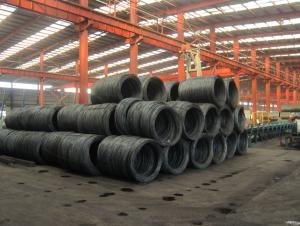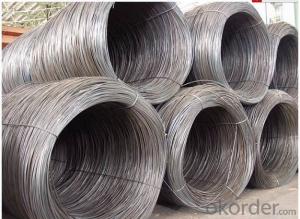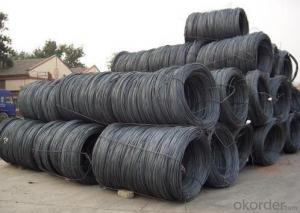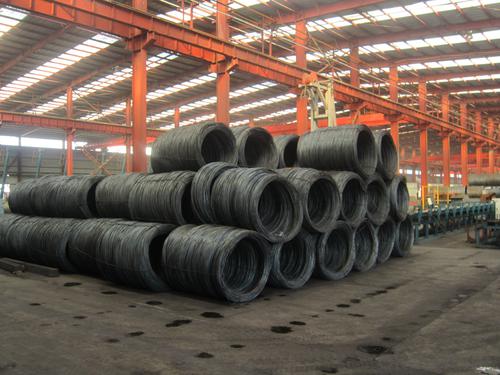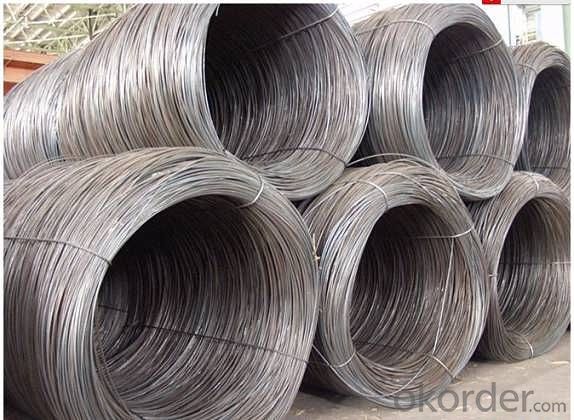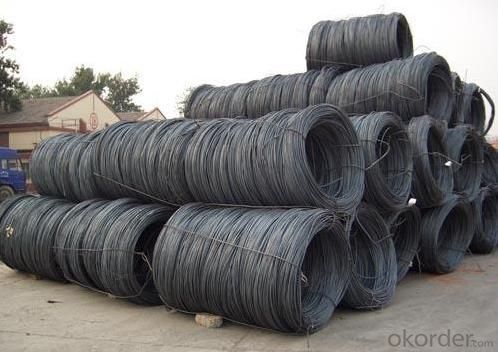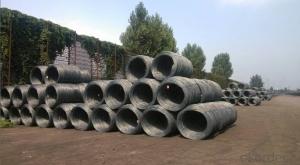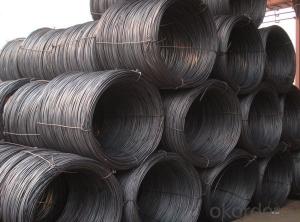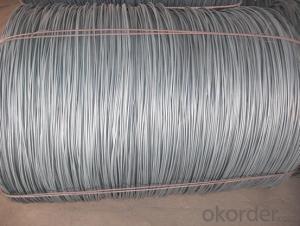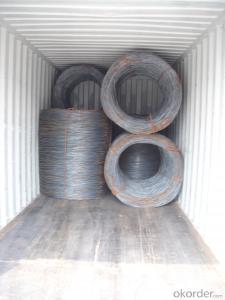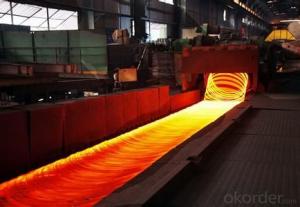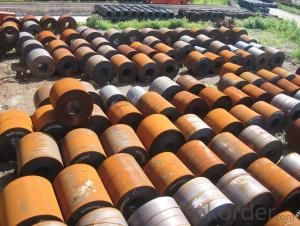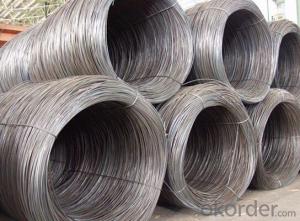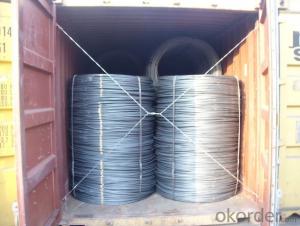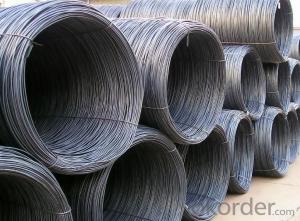GB Standard-Q195Steel Wire Rod with High Quality
- Loading Port:
- China Main Port
- Payment Terms:
- TT or LC
- Min Order Qty:
- 40 m.t
- Supply Capability:
- 15000 m.t/month
OKorder Service Pledge
OKorder Financial Service
You Might Also Like
Product Description:
Specifications of GB Standard-Q195Steel Wire Rod with High Quality:
Steel Grade: Q195 Standard:GB
Diameter: 6.5mm
6.5mm can be drawing into 2mm/8.0mm can be drawing into 3mm
Each coil weight about 2MT
Chemical Composition:
Please kindly find our chemistry of our material based on Q195 as below for your information
Trademark | Rank | Chemical composition (quality score) % | |||||
C | Si | Mn | S | P | |||
| ≤ |
| ≤ | ≤ | |||
Q195 |
| 0.06-0.12 | 0.30 | 0.25 | 0.050 | 0.045 | |
Trademark | Rank | Pulling Test | |||||
Bend PointΔs/Mpa | Tensile Strength | Elongation Ratioδ5% | |||||
Thickness (Diameter) /MM | Thickness (Diameter) /MM | ||||||
≤16 | 16-40 | ≤16 | 16-40 | ||||
≥ | ≥ | ||||||
Q195 |
| 195 | 185 | 315-390 | 33 | 32 | |
Usage and Applications of GB Standard-Q195Steel Wire Rod with High Quality:
After hot-rolled the products shaped into coil and delivery as finished product, including round, square, rectangular, hexagonal and so on. Since most of the products are round, it is generally called wire rod. Carbon steel wire rod is widely used in construction and manufacturing. Carbon steel wire rod is mainly used for reinforcement of reinforced concrete and welded structure or reprocessed (roberts , nail, etc.) materials, especially used to produce wire drawing, welding electrode, nails, spring, electronic, precise machinery parts and so on.
Production Process of GB Standard-Q195Steel Wire Rod with High Quality:
Steel billet---Heating---Rolling---Water-cooling---Coiling---Cooling---Inspection---Bundling---Exworks
Packaging & Delivery of GB Standard-Q195Steel Wire Rod with High Quality:
Packaging Detail: products are packed in coil and then shipped by container or bulk vessel
Each coil weight: About 2MT
Delivery Detail: within 45 days after received deposit or LC.
Label: to be specified by customer, generally, each bundle has 1-2 labels
Trade terms: FOB, CFR, CIF
FAQ:
Q1: How soon can we receive the product after purchasement?
A1: Within three days of placing an order, we will begin production. The specific shipping date is dependent upon international and government factors, but is typically one month.
Q2: How do you guarantee the quality of our products?
A2: We have established an advanced quality management system which conducts strict quality tests at every step, from raw materials to the final product. At the same time, we provide extensive follow-up service assurances as required.
Q3: The prices are invoicing on theoritical weight or on actual weight?
A3: We can do it in both manners, according to the customers' request.
Images of GB Standard-Q195Steel Wire Rod with High Quality:
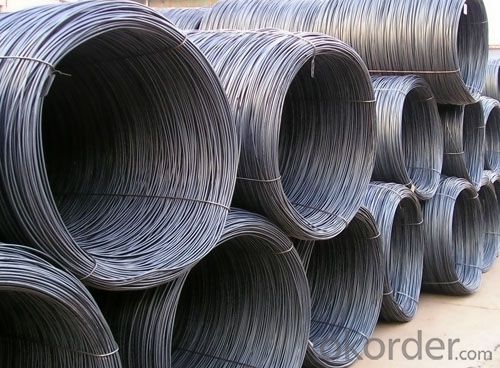
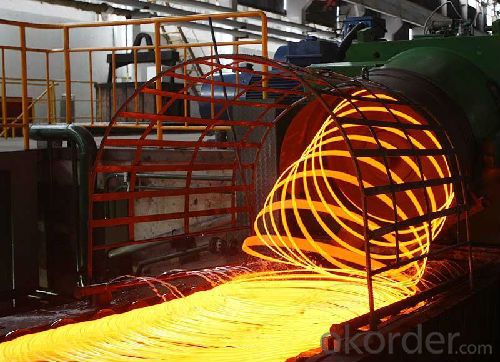
*If you would like to get our price, please kindly inform us the size, standard/material and quantity. Thank you very much for your attention.
- Q: What are the different surface defects that can affect the machinability of steel wire rod?
- There are several surface defects that can affect the machinability of steel wire rod. Some common examples include cracks, pits, scratches, scale, and decarburization. These defects can reduce the performance and quality of machined parts and may lead to increased tool wear and decreased productivity.
- Q: How is steel wire rod used in the manufacturing of clothes hangers?
- Clothes hangers rely on steel wire rods for their structural integrity. These rods serve as the foundation for the hanger, offering the required strength and durability to support various clothing items. They are typically molded into different shapes, such as the classic triangular form or the more contemporary slimline design. The production process begins by carefully selecting high-quality steel wire rods, usually crafted from either carbon steel or stainless steel. These rods are then fed into a machine that straightens and cuts them into specific lengths, depending on the desired hanger size. Once cut, the wire rods are transferred to a shaping machine, where they are bent and molded into the desired hanger shape. During the bending process, the steel wire rods are skillfully manipulated to form hooks and curves. This ensures that the hanger can securely hold different garments, including heavy coats or delicate dresses, without causing any damage or distortion. After shaping, a protective coating is often applied to the steel wire rods to prevent rust and enhance their appearance. The coating material may vary, ranging from plastic, vinyl, to powder coating, depending on the desired finish and functionality of the hanger. Once the steel wire rods have been shaped and coated, they are combined with other components, such as clips or non-slip features, to create the final clothes hanger. These additional parts may be made from different materials, but the steel wire rods remain the backbone of the hanger, providing the necessary strength and stability. Overall, steel wire rods play a vital role in clothes hanger manufacturing, offering a robust and enduring framework. Their ability to be molded into various designs ensures that hangers can accommodate different types of clothing, making them indispensable tools for organizing and storing garments.
- Q: What are the common industry training programs for steel wire rod?
- Some common industry training programs for steel wire rod include courses on manufacturing techniques, quality control, product standards and specifications, equipment operation and maintenance, safety protocols, and industry regulations. These programs aim to equip individuals with the necessary skills and knowledge to work effectively in the steel wire rod industry.
- Q: How are steel wire rods used in the production of welding electrodes?
- The production of welding electrodes relies heavily on steel wire rods, which serve as vital components. These wire rods function as the central material for welding electrodes, supplying the essential strength and conductivity needed for welding. To initiate the production of welding electrodes, steel wire rods are carefully chosen based on their specific mechanical properties. These properties, such as tensile strength and elongation, guarantee that the welding electrodes can endure the demanding conditions of high temperatures and stress encountered during welding. The steel wire rods then undergo further processing through a series of steps. Initially, they are cleansed and coated with a flux material. This coating aids in the elimination of impurities and facilitates improved arc stability during welding. Moreover, the coating helps create a protective gas shield around the welding area, preventing oxidation and contamination. Once the coating process is complete, the steel wire rods are cut into predetermined lengths and shaped according to the desired electrode design. This may involve bending or forming the rods to achieve the required shape and size for the welding electrode. Once the welding electrode is shaped, it is packaged and prepared for distribution and use. These electrodes find extensive applications in various industries, including construction, automotive, and manufacturing, where they are utilized for welding tasks like metal joining, machinery repair, and structure fabrication. In conclusion, steel wire rods play a critical role in the production of welding electrodes, providing the necessary strength, conductivity, and formability required for these electrodes to effectively carry out welding processes.
- Q: How is steel wire rod measured and classified?
- Steel wire rod is typically measured and classified based on its diameter, which is usually expressed in millimeters or inches. The classification is determined by the specific standards set by the industry, which takes into account the wire rod's chemical composition, tensile strength, and other mechanical properties. This ensures that the wire rod is suitable for its intended applications, such as in manufacturing various steel products or for construction purposes.
- Q: What are the different types of steel wire rod drawing machines?
- In the manufacturing industry, various types of steel wire rod drawing machines are utilized. Some of the frequently employed machines include: 1. The Single Block Drawing Machine: This machine, which is the simplest of its kind, employs a single block through which the wire rod is repeatedly passed to decrease its diameter. It is particularly suitable for drawing thin wires with utmost precision. 2. The Double Block Drawing Machine: As its name implies, this machine is equipped with two blocks through which the wire rod is threaded. Initially, the wire rod goes through the first block to reduce its diameter, and subsequently, it is passed through the second block to further decrease it. This machine is commonly employed for drawing medium-sized wires. 3. The Multi Block Drawing Machine: This type of machine features multiple blocks, in a sequential order, through which the wire rod is passed. Each block diminishes the diameter of the wire rod, resulting in a more precise and uniform wire. Multi block drawing machines are often utilized for drawing thicker wires. 4. The Bull Block Drawing Machine: Specifically designed for drawing large diameter wire rods, this machine employs a rotating bull block with grooves to reduce the wire's diameter. The wire rod is pulled through the rotating block, applying pressure and friction to diminish its diameter. 5. The Continuous Drawing Machine: This highly automated machine continually draws the wire rod to decrease its diameter. The wire rod is fed into the machine and passes through a series of blocks or dies that progressively reduce its diameter. Continuous drawing machines are commonly employed for mass production of wires. These are just a few examples of the diverse types of steel wire rod drawing machines available in the industry. The selection of the appropriate machine depends on the specific requirements of the wire being produced, such as diameter, precision, and production volume.
- Q: What are the different surface finishes available for steel wire rods?
- Steel wire rods offer a variety of surface finishes, each with its own unique properties and advantages. Some commonly used finishes include: 1. Black Oxide Finish: By treating the steel wire rod's surface with chemicals, a black oxide layer is formed. This finish enhances corrosion resistance and lubrication. 2. Galvanized Finish: Coating the steel wire rod with zinc provides excellent protection against corrosion. It is commonly used in outdoor or high humidity environments. 3. Electroplated Finish: Through electroplating, a thin layer of metal like nickel or chromium is applied to the steel wire rod's surface. This finish improves appearance, corrosion resistance, and durability. 4. Powder Coated Finish: A dry powder is applied to the steel wire rod's surface and then heated to create a protective and decorative layer. This finish offers exceptional resistance to chipping, scratching, and corrosion. 5. Phosphated Finish: Phosphating involves creating a layer of phosphate crystals on the steel wire rod's surface through a chemical process. This finish enhances adhesion, corrosion resistance, and lubrication. 6. Bare or Natural Finish: The steel wire rod is left untreated, without any additional coatings or finishes. It is typically used in applications where aesthetics are not a concern and emphasis is placed on strength and durability. The choice of surface finish for steel wire rods depends on specific application requirements, including corrosion resistance, appearance, lubrication, and environmental conditions.
- Q: How is the machinability of steel wire rod determined?
- The machinability of steel wire rod is determined by various factors such as its chemical composition, microstructure, hardness, and surface finish. These characteristics affect the ease with which the wire rod can be cut, drilled, or machined. Additionally, factors like the cutting tool material and geometry, cutting speed, and feed rate also play a role in determining the machinability of steel wire rod. By considering these factors, manufacturers can evaluate and optimize the machinability of steel wire rod for specific applications.
- Q: How is steel wire rod used in the manufacturing of window and door frames?
- Window and door frames often rely on steel wire rods for their strength and durability. These rods serve as reinforcement materials, providing structural support and stability to the frames. To prepare steel wire rods for use, they undergo a series of mechanical and chemical treatments. This process includes cleaning, descaling, and coating the rods to enhance their strength and resistance to corrosion. These treatments guarantee that the rods are suitable for window and door frame applications. Once prepared, the steel wire rods are shaped and formed into the desired frame structure. This can be achieved through various techniques such as bending, welding, or using specialized machinery to mold the rods into the required shape and size. To integrate the steel wire rods into the frame structure, they are typically welded or fastened together with other components. This integration improves the overall strength and stability of the frame, ensuring it can endure the weight and pressure it will face. Furthermore, the inclusion of steel wire rods in window and door frames enhances security and resistance against break-ins. The high tensile strength of these rods makes them difficult to bend or break, providing reliable protection for residential or commercial premises. Overall, utilizing steel wire rods in the manufacturing of window and door frames brings numerous benefits, such as increased strength, durability, and security. It guarantees that the frames can endure the test of time, maintain structural integrity, and enhance the visual appeal of any building.
- Q: How are steel wire rods used in the manufacturing of tire reinforcements for durability?
- Steel wire rods are utilized in the production of tire reinforcements to enhance durability, thanks to their exceptional strength and resilience. Typically composed of high-quality steel alloys, these rods offer excellent tensile strength and resistance to wear and tear. Within the tire manufacturing process, steel wire rods are employed to form the steel belts that are embedded within the tire's tread. These belts serve to fortify the tire and provide stability, particularly during high-speed driving or when carrying heavy loads. The steel wire rods are typically arranged in a crisscross fashion, ensuring optimal strength and structural integrity. By incorporating steel wire rods as tire reinforcements, the overall durability of the tire is enhanced. They aid in preventing deformation and provide heightened resistance against punctures, cuts, and impacts. Consequently, the tire's lifespan is prolonged, and its performance is enhanced. Additionally, the steel wire rods also play a pivotal role in improving the tire's grip on the road. The crisscross pattern of the steel belts enhances traction, resulting in better control and stability, particularly in wet or slippery conditions. This characteristic is particularly critical for vehicles that necessitate high-performance tires, such as sports cars or heavy-duty trucks. In conclusion, the utilization of steel wire rods in the production of tire reinforcements significantly contributes to the durability, safety, and performance of tires. Their strength, resilience, and ability to withstand various external forces make them an indispensable component within the tire manufacturing industry.
Send your message to us
GB Standard-Q195Steel Wire Rod with High Quality
- Loading Port:
- China Main Port
- Payment Terms:
- TT or LC
- Min Order Qty:
- 40 m.t
- Supply Capability:
- 15000 m.t/month
OKorder Service Pledge
OKorder Financial Service
Similar products
Hot products
Hot Searches
Related keywords
